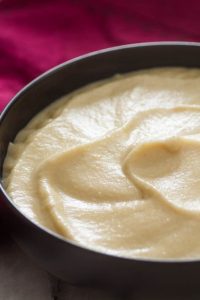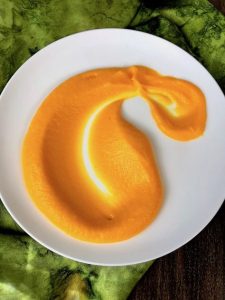Vegetable puree is a foundational food for many babies. It’s a smooth, easily digestible blend of cooked vegetables that introduces babies to new flavors and textures. But vegetable puree isn’t just for little ones! It’s a versatile ingredient that can be enjoyed by people of all ages.
This article will explore the wonderful world of vegetable puree, from its benefits for babies to delicious recipe ideas for the whole family.
The Benefits of Vegetable Puree for Babies
Vegetable puree is a vital part of introducing solid foods to babies. Here’s why:
Nutrient Rich:
Vegetables are packed with essential vitamins, minerals, and fiber, all important for a baby’s growth and development. Pureeing them makes these nutrients readily available for absorption.
Easy to Digest:
Pureed vegetables are smooth and easy for babies to swallow and digest. This is gentle on their developing digestive systems.
Exposure to New Flavors:
Vegetable puree introduces babies to a variety of tastes and colors, helping them develop their palates and encouraging them to try new foods.
Always consult with your doctor before introducing solid foods to your baby.
Creating Vegetable Purees for Babies
Making your own vegetable puree for your baby is a great way to control ingredients and ensure freshness. Here are some tips:
- Choosing Vegetables: Select a variety of colorful vegetables, like sweet potatoes, carrots, peas, and broccoli. Start with single-vegetable purees to identify any potential allergies.
- Cooking Methods: Steaming or boiling vegetables are healthy cooking methods that preserve nutrients. You can also roast vegetables to add a touch of sweetness.
- Pureeing Techniques: Once cooked, blend or mash the vegetables until they reach a smooth consistency. Add a little breast milk, formula, or water if needed to achieve the desired texture.
Remember, always store leftover baby food puree in the refrigerator or freezer and follow safe food handling practices.

Beyond the Basics: Vegetable Puree for All
Vegetable puree isn’t just for babies! It’s a versatile ingredient that can be enjoyed by people of all ages. Here are some ideas:
Soups and Sauces:
Use vegetable puree as a base for creamy soups or sauces. Add spices and herbs to create endless flavor variations.
Dips and Spreads:
Blend roasted vegetables with hummus, yogurt, or ricotta cheese to create flavorful dips and spreads for crackers or crudités.
Baked Goods:
Sneak some veggies into muffins, breads, or quick breads by adding pureed vegetables like zucchini or butternut squash.
Pasta Sauce Boost:
Add a spoonful of vegetable puree to your favorite pasta sauce for an extra dose of nutrients and a thicker consistency.
These are just a few ideas to get you started. With a little creativity, you can incorporate vegetable puree into many delicious dishes.
Flavor Combinations and Recipe Inspiration
Here are some flavor combinations and recipe ideas to inspire you to explore the world of vegetable puree:
- Sweet Potato Carrot Puree: This classic combination is naturally sweet and babies love it.
- Broccoli Apple Puree: A touch of apple sweetness balances the broccoli flavor, making it a great option for introducing new vegetables.
- Butternut Squash Soup with Sage: Pureed butternut squash makes a creamy and flavorful base for a comforting soup. Top with a drizzle of olive oil and a sprinkle of chopped sage.
- Roasted Cauliflower Dip with Herbs: Puree roasted cauliflower with tahini, lemon juice, and fresh herbs for a healthy and delicious dip.
There are endless possibilities when it comes to vegetable puree! Experiment with different flavors and textures to find your favorites.
Vegetable puree is a nutritious and delicious way to introduce babies to solid foods and can be enjoyed by people of all ages. By creating your own purees or using them as a creative ingredient in cooking, you can unlock a world of flavor and healthy possibilities.
 Vegetable Puree: Exploring Thickness and Texture
Vegetable Puree: Exploring Thickness and Texture
Vegetable puree can be enjoyed at various stages of thickness and texture, depending on your preference and intended use. Here’s a breakdown:
Smooth Puree:
This is the classic consistency for babies. It’s completely smooth and easy to swallow. You can achieve this by blending or mashing cooked vegetables until no lumps remain.
Slightly Chunky Puree:
As babies develop their ability to swallow, a slightly chunkier puree can be introduced. This can be made by leaving a few small, soft bits of vegetable in the puree.
Creamy Soups and Sauces:
Vegetable puree can be used as a base for creamy soups and sauces. To achieve a creamy texture, you can blend the puree with ingredients like cashews, avocado, or coconut milk.
Hearty Dips and Spreads:
For dips and spreads, you might prefer a thicker consistency. Roast vegetables add natural sweetness and a thicker texture. Experiment with blending roasted vegetables with ricotta cheese, hummus, or yogurt.
Baked Goods with Puree:
When incorporating puree into baked goods like muffins or breads, you may need to adjust the liquid content in the recipe. Denser vegetables like butternut squash or sweet potato will add more moisture than leafy greens.
Experimenting with thickness and texture allows you to tailor vegetable puree to different uses and preferences.
Vegetable Puree and Food Safety
Ensuring the safety of your purees is important, especially when feeding babies. Here are some key food safety practices:
Wash Produce Thoroughly:
Wash all fruits and vegetables before cooking or preparing them for puree. This removes dirt, bacteria, and pesticide residue.
Proper Cooking:
Cook vegetables thoroughly to kill any harmful bacteria. Steaming or boiling are good options to preserve nutrients.
Safe Food Handling:
Always practice good hygiene when preparing food. Wash your hands thoroughly before handling ingredients and avoid cross-contamination.
Storage Guidelines:
Store leftover purees in airtight containers in the refrigerator for up to 3 days or freeze them in portion sizes for longer storage.
Following these simple guidelines will help ensure that your vegetable purees are safe and enjoyable for everyone.
Conclusion
Vegetable puree offers a world of flavor and versatility. From introducing babies to solid foods to creating delicious dishes for the whole family, the possibilities are endless. With a little creativity and attention to food safety, you can unlock the full potential of this nutritious and delicious ingredient.
